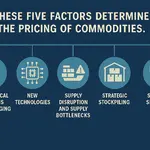
The Hidden Forces Behind Strategic Metals Price Swings
May 12, 2025
Weekly News Review May 19 – May 25 2025
May 25, 2025This week, the United States deepened its partnership with Saudi Arabia, signing investment agreements across key sectors, including mining and defense. Meanwhile, China, the world’s leading supplier of critical raw materials, vowed to intensify its crackdown on mineral smuggling.
All this and more in our weekly news review,
UNITED STATES AND SAUDI ARABIA SIGN $600 BILLION INVESTMENT AGREEMENT: RARE EARTHS FEATURE AS WELL AS DEFENCE AND HEALTHCARE –
Bilateral investment spans multiple sectors; geological collaboration to deepen.
The United States and Saudi Arabia have concluded a $600 billion investment agreement, signed Tuesday in Riyadh by U.S. President Donald Trump and Saudi Crown Prince Mohammed bin Salman. The deal includes commitments from American and Saudi companies to invest in each other’s economies across strategic sectors such as energy infrastructure, healthcare, data centers, and defense.
A key component of the agreement is enhanced cooperation in the mining and mineral resources sector. Under a Memorandum of Cooperation, the two countries are set to collaborate on critical mineral supply chains, including mining and processing, and will explore joint investment opportunities. As part of its Vision 2030 economic diversification plan, Saudi Arabia aims to reduce its reliance on oil revenues by developing its vast, largely untapped mineral reserves, estimated by the government to be worth $2.5 trillion. These include valuable resources such as lithium, gold, and rare earth elements.
The agreement, originally announced last week before President Trump’s visit, marks a significant step forward in U.S.-Saudi economic relations, according to the White House. It also aligns with recent U.S. initiatives to secure critical mineral supply chains. President Trump signed a minerals agreement with Ukraine earlier this month following prolonged negotiations.
CHINA STEPS UP CRACKDOWN ON STRATEGIC METALS SMUGGLING:
Increase in illicit activity after the implementation of export controls.
Chinese authorities are intensifying efforts to combat the smuggling of critical minerals. According to a statement from the Ministry of Commerce, since introducing export controls on strategic materials such as gallium, germanium, antimony, tungsten, and certain rare earth elements, foreign companies have increasingly cooperated with domestic criminal networks to circumvent the restrictions.
Officials from the Ministry of Commerce, the Ministry of Public Security, the General Administration of Customs, the Supreme People’s Court, and other government bodies convened in Shenzhen last Friday to discuss countermeasures. Among the key concerns is rerouting restricted materials through third countries to bypass trade regulations. To address these challenges, the authorities emphasized the need to strengthen law enforcement capabilities and to develop intelligent monitoring systems to detect and prevent illegal activities more effectively.
NEO PERFORMANCE MATERIALS RELEASES Q1 REVENUE REPORT:
The magnet segment shines; the Estonia plant is on track.
Neo Performance Materials reported its first-quarter results on Friday, posting flat revenue amid ongoing market challenges. Revenue for the quarter came in at $121.6 million, representing a slight 0.41% decline from the same period last year.
Despite the overall flat revenue performance, the company also highlighted progress during the quarter. Notably, its magnet segment delivered a 7.3% year-over-year increase in sales volume. Neo also reaffirmed that its large-scale commercial magnet plant in Estonia remains on schedule and within budget.
However, Neo also highlighted challenges for the rare earth industry during the earnings call: Geopolitical tensions, including the imposed trade tariffs by the United States and global repercussions, as well as China’s recent export controls on seven of the 17 rare earth elements, have caused unrest in the sector. In addition, currency fluctuations and broader macroeconomic pressures could pose further headwinds for the industry.
UNITED STATES MP MATERIALS TO JOIN FORCES WITH SAUDI ARABIA MA’ADEN IN RARE EARTHS:
The announcement comes just a day after the state leaders signed a deeper economic agreement.
Saudi Arabia’s state mining company, Ma’aden, and U.S.-based MP Materials have signed a Memorandum of Understanding (MoU) to jointly pursue the development of a fully integrated rare earth supply chain. The project will cover the entire value chain from mining and separation to refining and magnet production.
The MoU was signed during the U.S.-Saudi Investment Forum 2025, held in Riyadh. It came just a day after the United States and Saudi Arabia announced a $600 billion investment agreement focusing on strengthening cooperation in mining, defense, energy, and technology (we reported).
The two countries signed a Memorandum of Cooperation on developing mineral supply chains as part of that larger deal. Saudi Arabia is looking to tap into its estimated $2.5 trillion mineral reserves, including rare earths, as part of its Vision 2030 plan to diversify its economy beyond oil.
Maaden operates 17 mines and sites across Saudi Arabia, with products currently exported to 55 countries worldwide. Ahead of the Investment Forum, the company had already signaled plans to seek international partners to support its development in critical minerals. MP Materials, the only large-scale U.S. rare earth miner, was among the companies analysts had pointed to as a likely collaborator.
CHINA’S SHENGHE TO ACQUIRE 100% OF AUSTRALIAN RARE EARTH FIRM:
It would give the Chinese raw materials giant a controlling stake in Peak’s Tanzanian rare earth project.
Chinese rare earth giant Shenghe Resources is eyeing the next move in its international expansion. According to media reports, its subsidiary, Chenguang Rare Earth, plans to acquire 100% of the equity in Peak Rare Earths Limited, an Australian-listed company developing the Ngualla Rare Earth Project in southern Tanzania.
This proposed acquisition builds on Shenghe’s investment in July 2024, when it secured a 50% stake in Ngualla Group, the holding company for Peak’s 84% interest in the Ngualla project (we reported). Even before this development, Shenghe had already acquired a 19.9% stake in Peak Rare Earths and secured exclusive rights to the project’s entire rare earth concentrate production for seven years.
The acquisition is expected to undergo regulatory scrutiny in both Australia and China. Due to the sensitive nature of rare earths in the context of national security, it may trigger foreign investment reviews. Australia has previously blocked two Chinese investments in its rare earth sector and has since taken a more cautious stance on foreign direct investment in critical minerals.
UNITED STATES: UCORE SECURES DOD FUNDING TO ADVANCE RARE EARTH PROCESSING IN LOUISIANA –
U.S. Department of Defense engagement highlights the importance of critical mineral supply.
Ucore Rare Metals has secured $18.4 million in funding from the U.S. Department of Defense (DoD) to advance its rare earth separation technology toward full-scale commercial operation in Louisiana. This latest round of funding expands on the Canadian company’s existing demonstration project with the DoD and will support the transition to commercial-scale production. Construction and early production are slated to begin in the second half of 2026, with the facility ultimately targeting an annual processing capacity of 2,000 tons of total rare earth oxides (TREO).
Ucore aims to produce a wide array of rare earth elements, including neodymium, praseodymium, dysprosium, terbium, samarium, and gadolinium. Some of these are subject to export controls by China, the world’s leading producer.
The DoD funding comes as Ucore builds its rare earth supply network. Over the past year, the company has signed multiple agreements to secure feedstock for its Louisiana facility, including a Memorandum of Understanding with Australia’s ABx for rare earth carbonate from Tasmania, and a deal with Canadian recycler Cyclic Materials for mixed recycled rare earth oxides. Ucore has also locked in future supply from Meteoric Resources’ project in Brazil.
Through this supply network, Ucore aims to establish a North American rare earth value chain, reducing reliance on foreign sources and boosting the region’s global competitiveness. “This funding is critical for both Ucore’s commercial development and the broader Western rare earth processing capability,” said CEO Pat Ryan.
CHINA: NO LIFTING OF EXPORT RESTRICTIONS ON RARE EARTHS IN SIGHT –
Earlier this week, the U.S. and China signaled a tentative easing in their trade dispute, agreeing to lower tariffs on each other’s goods for 90 days and resume negotiations. This development sparked hopes that China might also reduce its export restrictions on certain rare earth elements, introduced in early April. However, contrary to some media reports, these measures did not amount to an outright export ban. Still, the newly required licensing procedures have significantly slowed supply chains, affecting industrial deliveries.
Although the restrictions are not explicitly targeted at any specific country, China simultaneously imposed sanctions on dozens of U.S. companies, primarily in the defense sector, blocking their access to raw materials. As of Wednesday, this special restriction has been suspended for 90 days. While the move may give the impression of a broader relaxation, it merely places the sanctioned firms under the same licensing regime as other customers. Chinese suppliers must still apply for export licenses, and approval is not guaranteed, the Ministry of Commerce clarified.
In short, the current export controls on dysprosium, terbium, yttrium, gadolinium, samarium, lutetium, scandium, and their compounds have not changed. Chinese authorities have also pledged to tighten enforcement to prevent smuggling, with agencies coordinating new measures at a recent interdepartmental meeting.
KAZAKHSTAN: INVESTORS TARGET STRATEGIC METALS WEALTH WITH $1 BILLION POURED INTO SECTOR –
The Central Asian nation plans to ramp up exploration and unlock more resource potential by 2026.
Kazakhstan, located in Central Asia, is home to significant deposits of critical minerals and aims to position itself as a key global producer. This ambition draws growing international interest: over the past five years, approximately $1 billion in private investment has flowed into the country’s mining sector. Margulan Baibatyrow, Deputy Chairman of the Geology Committee at the Ministry of Industry and Construction, announced the figure.
According to the Astana Times, international corporations have contributed nearly $81 million to geological exploration alone. Just weeks ago, Kazakhstan reported the discovery of its largest rare earth deposit, estimated at 20 million tonnes. The government plans to increase production of these critical raw materials by 40 percent in the coming years (we reported).
Only a fraction of deposits have been explored so far:
According to mining.com, Kazakhstan’s official geological records list over 980 deposits of solid mineral resources. Since 2018, the country has issued 2,906 exploration licenses and 111 production licenses. However, active exploration is currently taking place at only a dozen sites.
To address this, Baibatyrow announced plans to expand the country’s geologically surveyed area by one-third by early 2026, from 1.6 million to 2.2 million square kilometers. Still, he noted that funding for further exploration remains insufficient. Other challenges include a shortage of skilled personnel. One industry expert also flagged a potential risk for Kazakhstan’s emerging rare earths sector: the loss of value creation if raw materials are exported for processing elsewhere. Developing a domestic high-tech industry that would use rare earths in products ranging from smartphones to electric motors is unlikely.
AUSTRALIA’S LYNAS CORP BECOMES FIRST SUPPLIER OF RARE EARTHS OUTSIDE CHINA:
Milestone achievement for the Australian company, a shift for global supply chains?
In its latest quarterly report, Lynas announced it would begin producing dysprosium in May, followed by terbium in June. The company appears to be right on schedule: the first batch of dysprosium oxide has now been successfully produced at its refinery in Malaysia (PDF). According to the company, this marks a significant milestone — Lynas is now the first supplier of this complex-to-produce material outside of China.
The company, under CEO Amanda Lacaze, has ambitious plans. In addition to mining raw materials in Australia, Lynas is considering acquiring deposits in Brazil and Malaysia. Particularly promising are ion-adsorption clays, which contain high concentrations of heavy rare earth elements like dysprosium and terbium—materials that are currently in high demand due to China’s export restrictions.
Figure of the Week: – 40% of primary cobalt demand could be reduced by 2050 through battery recycling.






